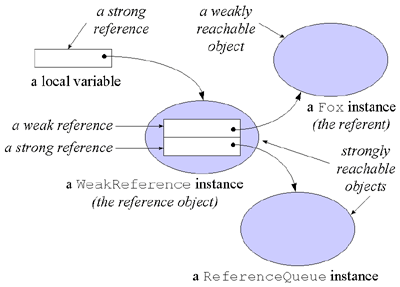|
|
|
Sponsored Link •
|
|
Advertisement
|
As mentioned previously, the purpose of reference objects is to enable you to hold references to objects that the garbage collector is free to collect. Put another way, the garbage collector is allowed to change the reachability state of any object that is not strongly reachable. Because it is often important to keep track of reachability state changes brought about by the garbage collector when you hold soft, weak, or phantom references, you can arrange to be notified when such changes occur. To register interest in reachability state changes, you associate reference objects with reference queues. A reference queue is an instance of class java.lang.ref.ReferenceQueue to which the garbage collector will append (or "enqueue") reference objects involved in reachability state changes. By setting up and monitoring reference queues, you can stay apprised of interesting reachability state changes performed asynchronously by the garbage collector.
To associate a reference object with a reference queue, you simply pass a reference to the reference queue as a constructor parameter when you create the reference object. A reference object so created, in addition to holding a reference to the referent, will hold a reference to the reference queue. When the garbage collector makes a relevant change to the reachability state of the referent, it will append the reference object to its associated reference queue. For example, when the WeakReference object shown in Figure 9-5 was created, two references were passed to the constructor: a reference to a Fox object and a reference to a ReferenceQueue object. When the garbage collector decides to collect the weakly reachable Fox object, it will clear the WeakReference object and either at that or some later time append the WeakReference object to its reference queue.

To append a reference object to the end of its associated queue, the garbage collector invokes enqueue() on the reference object. The enqueue() method, which is defined in superclass Reference, appends the reference object to a reference queue only if the object was associated with a queue when it was created, and only the first time enqueue() is invoked on the object. Programs can monitor a reference queue in two ways, either by polling with the poll() method or by blocking with the remove() method. If a reference object is waiting in the queue when either poll() or remove() is invoked on the queue object, the method will remove that object from the reference queue and return it. If no reference object is waiting in the queue, however, poll() will immediately return null, but remove() will block until the next reference object gets enqueued. Once a reference objects arrives in the queue, remove() will remove and return it.
The garbage collector enqueues soft, weak, and phantom reference objects in different situations to indicate three different kinds of reachability state changes. The meanings of the six reachability states and the circumstances under which state changes occur are as follow:
finalize() method itself, then its finalizer will have been run), and is reachable from the roots via one or more (uncleared) phantom reference objects. As soon as an object referenced by a phantom reference object becomes phantom reachable, the garbage collector will enqueue it. The garbage collector will never clear a phantom reference. All phantom references must be explicitly cleared by the program.
Note that whereas the garbage collector enqueues soft and weak reference objects when their referents are leaving the relevant reachability state, it enqueues phantom references when the referents are entering the relevant state. You can also see this difference in that the garbage collector clears soft and weak reference objects before enqueueing them, but not phantom reference objects. Thus, the garbage collector enqueues soft reference objects to indicate their referents have just left the softly reachable state. Likewise, the garbage collector enqueues weak reference objects to indicate their referents have just left the weakly reachable state. But the garbage collector enqueues phantom reference objects to indicate their referents have entered the phantom reachable state. Phantom reachable objects will remain phantom reachable until their reference objects are explicitly cleared by the program.
|
Sponsored Links
|